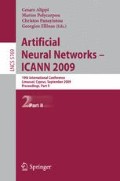Abstract
Recently the notion of power law networks in the context of neural networks has gathered considerable attention. Some empirical results show that functional correlation networks in human subjects solving certain tasks form power law graphs with exponent approaching ≈ 2. The mechanisms leading to such a connectivity are still obscure, nevertheless there are sizable efforts to provide theoretical models that would include neural specific properties. One such model is the so called spike flow model in which every unit may contain arbitrary amount of charge, which can later be exchanged under stochastic dynamics. It has been shown that under certain natural assumptions about the Hamiltonian the large-scale behavior of the spike flow model admits an accurate description in terms of a winner-take-all type dynamics. This can be used to show that the resulting graph of charge transfers, referred to as the spike flow graph in the sequel, has scale-free properties with power law exponent γ= 2. In this paper we analyze the spectra of the spike flow graphs with respect to previous theoretical results based on the simplified winner-take-all model. We have found numerical support for certain theoretical predictions and also discovered other spectral properties which require further theoretical investigation.
Access this chapter
Tax calculation will be finalised at checkout
Purchases are for personal use only
Preview
Unable to display preview. Download preview PDF.
References
Li, L., Alderson, D., Tanaka, R., Doyle, J.C., Willinger, W.: Towards a theory of scale-free graphs: Definition, properties, and implications (extended version) (2005)
Albert, R., Jeong, H., Barabási, A.L.: Diameter of the world-wide web. Science 401, 130–131 (1999)
Barabási, A.L., Jeong, H., Néda, Z., Ravasz, E., Schubert, A., Vicsek, T.: Evolution of the social network of scientific collaborations. Physica A 311(4), 590–614 (2002)
Redner, S.: How popular is your paper? an empirical study of the citation distribution. European Physical Journal B 4(2), 131–134 (1998)
Montoya, J.M., Solé, R.V.: Small world patterns in food webs. Journal of Theoretical Biology 214(3), 405–412 (2002)
i Cancho, R.F., Solé, R.V.: The small-world of human language. Proceedings of the Royal Society of London B 268(1482), 2261–2265 (2001)
Bhalla, U.S., Iyengar, R.: Emergent properties of networks of biological signaling pathways. Science 283(5400), 381–387 (1999)
Jeong, H., Tombor, B., Albert, R., Oltvai, Z.N., Barabási, A.L.: The large-scale organization of metabolic networks. Nature 407(6804), 651–653 (2000)
Abello, J., Buchsbaum, A., Westbrook, J.: A functional approach to external graph algorithms. In: Bilardi, G., Pietracaprina, A., Italiano, G.F., Pucci, G. (eds.) ESA 1998. LNCS, vol. 1461, pp. 332–343. Springer, Heidelberg (1998)
Aiello, W., Chung, F., Lu, L.: A random graph model for massive graphs. In: STOC 2000: Proceedings of the thirty-second annual ACM symposium on Theory of computing, pp. 171–180. ACM, New York (2000)
Amaral, L.A., Scala, A., Barthelemy, M., Stanley, H.E.: Classes of small-world networks. Proc. Natl. Acad. Sci. U.S.A. 97(21), 11149–11152 (2000)
Koch, C., Laurent, G.: Complexity and the Nervous System. Science 284(5411), 96–98 (1999)
Eguíluz, V.M., Chialvo, D.R., Cecchi, G.A., Baliki, M., Apkarian, A.V.: Scale-free brain functional networks. Phys. Rev. Lett. 94(1) (2005)
Sporns, O., Chialvo, D.R., Kaiser, M., Hilgetag, C.C.: Organization, development and function of complex brain networks. Trends. Cogn. Sci. 8(9), 418–425 (2004)
Chung, F., Lu, L.: Complex Graphs and Networks (Cbms Regional Conference Series in Mathematics). American Mathematical Society, Boston (2006)
Perotti, J.I., Tamarit, F.A., Cannas, S.A.: A scale-free neural network for modelling neurogenesis. Physica A Statistical Mechanics and its Applications 371, 71–75 (2006)
Stauffer, D., Aharony, A., da Fontoura Costa, L., Adler, J.: Efficient hopfield pattern recognition on a scale-free neural network. The european physical journal B (32), 395–399 (2003)
Barabási, A.L., Albert, R.: Emergence of scaling in random networks. Science (286), 509–512 (1999)
Piȩkniewski, F., Schreiber, T.: Emergence of scale-free spike flow graphs in recurrent neural networks. In: Proc. IEEE Symposium Series in Computational Intelligence - Foundations of Computational Intelligence, Honolulu, Hawai USA, pp. 357–362 (2007)
Piȩkniewski, F., Schreiber, T.: Spontaneous scale-free structure of spike flow graphs in recurrent neural networks. Neural Networks 21(10), 1530–1536 (2008)
Schreiber, T.: Spectra of winner-take-all stochastic neural networks (2008). In review, available at arXiv, http://arxiv.org/abs/0810.3193
Chung, F.R.K.: Spectral Graph Theory. CBMS Regional Conference Series in Mathematics, vol. 92. American Mathematical Society (1997)
Author information
Authors and Affiliations
Editor information
Editors and Affiliations
Rights and permissions
Copyright information
© 2009 Springer-Verlag Berlin Heidelberg
About this paper
Cite this paper
Piekniewski, F. (2009). Spectra of the Spike Flow Graphs of Recurrent Neural Networks. In: Alippi, C., Polycarpou, M., Panayiotou, C., Ellinas, G. (eds) Artificial Neural Networks – ICANN 2009. ICANN 2009. Lecture Notes in Computer Science, vol 5769. Springer, Berlin, Heidelberg. https://doi.org/10.1007/978-3-642-04277-5_61
Download citation
DOI: https://doi.org/10.1007/978-3-642-04277-5_61
Publisher Name: Springer, Berlin, Heidelberg
Print ISBN: 978-3-642-04276-8
Online ISBN: 978-3-642-04277-5
eBook Packages: Computer ScienceComputer Science (R0)

